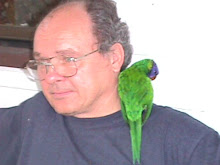available at http://pt.treknature.com/gallery/photo123389.htm

Odd thing the memory. Had I been asked I would have assured listeners that among the very first birds Fay and I recorded at Allen Road was the Noisy Friarbird Philemon corniculatus, a member of the honeyeater brigade. Yes, there was also Little Friarbird Philemon citreogularis but assuredly the noisier of the pair was there on that first day [13 April 2001].
It wasn’t.
That’s one of the advantages of keeping meticulous records. I’m a Dreamtine “dolphin” personality and dolphins revel in the keeping of lists. I am an almost pedantic keeper of records. Our bird lists go back to that first day in 2001 and on every visit, until we finally settled here in 2005, we recorded every bird seen and/or heard on or flying over the property on the occasion of every visit. We extended that to the entire 2km length of the street and Des’s 67ha paddock which abuts onto the southern boundary.
The simple fact is that 13 April 2001 was a quick inspection; one of several properties we had looked over that weekend. Only three species were actually recorded that day: the Little Friarbird, officially the first bird on our Backyard List, followed by Wedge-tailed Eagle Aquila audax and the Noisy Miner Manorina melanocephala, another of Australia’s many honeyeaters.
I knew there was a “noisy” something or other among the early bag.
Nor did we record Noisy Friarbird on our second visit to the property [21 April 2001]. The Backyard List expanded to 17 species but Noisy Friarbird was not among them:
By the end of May 2001 [covering our first four visits] the tally stood at 34 species. It included some real gems: Little Woodswallow Artamus minor, .Speckled Warbler Chthonicola sagittatus, and Pacific Baza Aviceda subcristata but it did not include Noisy Friarbird.
At the end of August 2001 the Backyard List had swelled to 67 species. Among them we could count further gems such as Spotted Pardalote Pardalotus punctatus, Restless Flycatcher Myiagra inquieta, Eastern Spinebill Acanthorhynchus tenuirostris, Little Eagle Aquila morphnoides, both the Yellow-tailed and Glossy Black-Cockatoos Calyptorhynchus funereus and Calyptorhynchus lathami respectively and the mega Australian Owlet-nightjar Aegotheles cristatus.
In fact our first Allen Road Backyard List Noisy Friarbird was not recorded until 2 September 2001, on the 33rd day of records.
They continue to visit each year and one day Fay and I will make the effort to search for their nesting sites which must be somewhere on the property.
And speaking of nests, it is pleasing to record that the Magpie-larks Grallina cyanoleuca have successfully fledged their second brood of two youngsters. They had originally fledged two on their first attempt, failed with their second nest [placing it in the most absurdly exposed site imaginable] and now have added a further duo of Magpie-larks to the world.
This year the Sacred Kingfisher Todiramphus sanctus moved from the termite mound on the edge of the drive to one on the southern edge of the property, a little beyond the dam. The Double-barred Finch Taeniopygia bichenovii have moved from their favoured orchard haunt to take up nesting residence behind the vegetable garden. The Apostlebirds Struthidea cinerea, Crested Pigeons Ocyphaps lophotes and Bar-shouldered Doves Geopelia humeralis have continued to thrive and nest on the property. The young Olive-backed Oriole Oriolus sagittatus is calling even as I tap out these few words and we have noted a number of “green-faced” Blue-faced Honeyeaters Entomyzon cyanotis at the two main feeders.
This year the Sacred Kingfisher Todiramphus sanctus moved from the termite mound on the edge of the drive to one on the southern edge of the property, a little beyond the dam. The Double-barred Finch Taeniopygia bichenovii have moved from their favoured orchard haunt to take up nesting residence behind the vegetable garden. The Apostlebirds Struthidea cinerea, Crested Pigeons Ocyphaps lophotes and Bar-shouldered Doves Geopelia humeralis have continued to thrive and nest on the property. The young Olive-backed Oriole Oriolus sagittatus is calling even as I tap out these few words and we have noted a number of “green-faced” Blue-faced Honeyeaters Entomyzon cyanotis at the two main feeders.
The Torresian Crows Corvus orru continue to stuff food down the throat of their clamourous youngster while the White-winged Chough Corcorax melanorhamphos appear to present with a little more decorum when feeding their young.
And while there are sadly no old, hollowed, trees on our property, the Galahs Eolophus roseicapilla, Rainbow Lorikeets Trichoglossus haematodus and Australian King-Parrots Alisterus scapularis [all hollow nesters] do at least continue to bring their juveniles to the Allen Road Avian Café Bar.

No comments:
Post a Comment